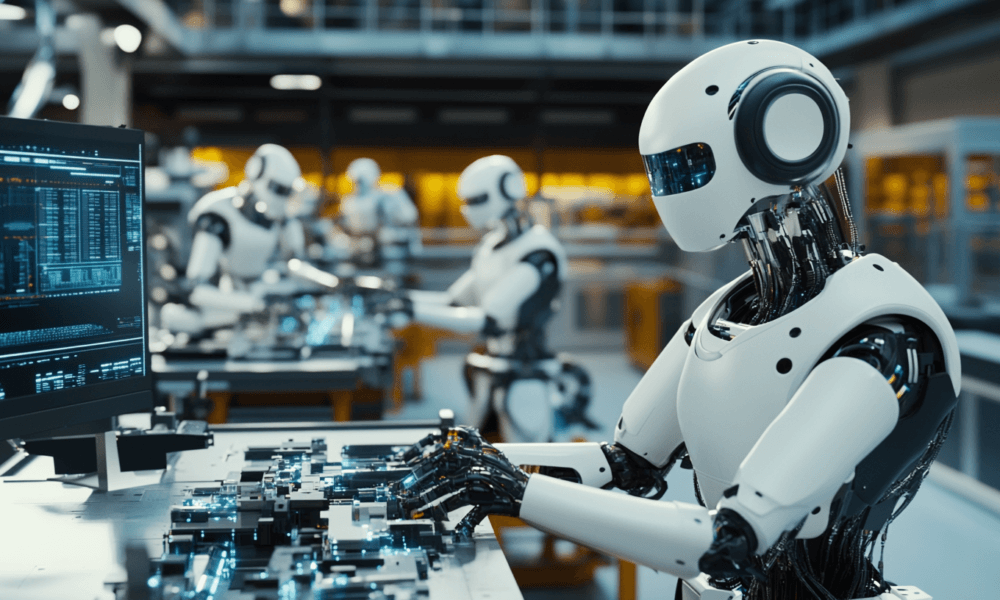The Impact of Automation on the Future of Work: Preparing for a Changing Landscape
Automation has become a defining feature of the modern workplace. From advanced robotics in manufacturing to sophisticated AI algorithms in customer service, automation is transforming how work is done across industries. While automation offers numerous benefits, such as increased efficiency, lower costs, and improved safety, it also presents significant challenges, particularly concerning employment and job displacement. As automation continues to evolve, it’s essential to understand its impact on the workforce and how individuals, businesses, and governments can prepare for the changes ahead. In this article, we will analyze the potential effects of automation on employment, the risks of job displacement, and the strategies needed for workforce adaptation in a rapidly changing landscape.
The Rise of Automation in the Workplace
1. What is Automation?
Automation refers to the use of technology to perform tasks with minimal human intervention. It can involve physical machinery, software, or a combination of both to execute repetitive tasks, streamline processes, and enhance productivity. Automation has been a part of industrial work since the advent of machines, but recent advancements in artificial intelligence (AI), machine learning (ML), and robotics have significantly expanded its capabilities.
- Industrial Automation: Automation in manufacturing has been common for decades. Robotic arms on assembly lines, for example, can perform tasks like welding, painting, and quality control with high precision and speed.
- Cognitive Automation: Advances in AI have led to cognitive automation, which allows machines to perform tasks that involve decision-making, pattern recognition, and even natural language processing. Examples include AI chatbots, fraud detection systems, and automated data analysis.
The Impact of Automation on Employment
1. Job Creation vs. Job Displacement
One of the most significant concerns about automation is its impact on employment. Automation has the potential to both create and displace jobs, and understanding this dual effect is crucial.
- Job Displacement: Many routine and repetitive jobs are at risk of being replaced by automation. Roles in manufacturing, retail, and administrative tasks are particularly vulnerable. For instance, self-checkout machines are replacing cashiers, while automated customer service chatbots are taking over traditional customer support roles.
- Job Creation: On the other hand, automation can create new opportunities, particularly in industries related to technology, engineering, and services. Jobs in AI development, data analysis, and automation maintenance are in demand as automation technology grows. Robotic process automation (RPA) specialists, data scientists, and AI trainers are just some of the emerging roles in the new economy.
2. The Shift in Job Roles and Skills
Automation is also reshaping existing job roles, with many tasks that were once performed manually now being automated. As a result, the nature of work is changing, and employees need to adapt by acquiring new skills.
- Augmentation vs. Replacement: In many cases, automation is used to augment rather than replace human workers. For example, AI can assist doctors by analyzing medical images, allowing healthcare professionals to make more accurate diagnoses. In such cases, humans and machines work together, enhancing overall productivity and outcomes.
- Demand for New Skills: As automation continues to evolve, the demand for skills such as data literacy, critical thinking, and creativity is increasing. Workers need to develop both technical and soft skills to remain competitive in an automated workplace. Reskilling and upskilling are becoming essential strategies for adapting to the changes brought about by automation.
Challenges of Automation: Job Displacement and Inequality
1. Job Displacement and Economic Inequality
The risk of job displacement due to automation is a major concern, particularly for low-skilled workers who are more vulnerable to job loss. Automation tends to disproportionately affect jobs that involve repetitive tasks, which are often held by lower-wage workers.
- Economic Inequality: Job displacement can exacerbate economic inequality. Workers who lose their jobs due to automation may struggle to find new employment, particularly if they lack the skills needed for the jobs that are being created. This can lead to increased inequality between high-skilled and low-skilled workers.
- Geographic Disparities: Regions that are heavily reliant on industries vulnerable to automation, such as manufacturing, may face greater economic challenges. This can create geographic disparities in employment opportunities and economic stability.
2. Workforce Adaptation: The Need for Reskilling
To mitigate the negative impacts of automation, a significant focus must be placed on workforce adaptation. Governments, businesses, and educational institutions all have a role to play in preparing workers for a changing job landscape.
- Reskilling Initiatives: Reskilling programs are essential for helping displaced workers transition to new careers. These programs focus on teaching new skills that are in demand, such as programming, data analysis, and digital marketing. Many companies are investing in reskilling initiatives to support their employees in adapting to technological changes.
- Lifelong Learning: Lifelong learning is becoming increasingly important as the pace of technological change accelerates. Workers must continuously update their skills to keep up with the evolving demands of the job market. Online learning platforms like Coursera, Udemy, and edX offer courses that make it easier for individuals to learn new skills and stay competitive.
Opportunities Presented by Automation
1. Increased Productivity and Economic Growth
One of the most significant benefits of automation is its ability to increase productivity. By automating repetitive and mundane tasks, businesses can focus on more complex and value-added activities, leading to greater economic growth.
- Business Efficiency: Automation allows companies to operate more efficiently by reducing human error, speeding up processes, and minimizing costs. This increased efficiency can lead to higher profits and the potential to reinvest in growth and innovation.
- Global Competitiveness: Countries and companies that embrace automation are likely to be more competitive on the global stage. By leveraging automation technologies, businesses can increase their production capabilities, reduce costs, and offer better products and services.
2. Enhancing Human Potential
Automation also presents an opportunity to enhance human potential by taking over mundane tasks and freeing up time for more creative and strategic work. This allows workers to focus on activities that require human ingenuity, emotional intelligence, and critical thinking.
- Focus on Creativity: By automating routine tasks, workers can focus on tasks that require creativity and innovation. This shift has the potential to lead to breakthroughs in fields such as research, technology, and the arts.
- Work-Life Balance: Automation can also improve work-life balance by reducing the time spent on repetitive tasks. By allowing workers to focus on more meaningful activities, automation can contribute to greater job satisfaction and overall well-being.
Preparing for a Changing Landscape: Strategies for Adaptation
1. Embracing a Growth Mindset
To thrive in an era of automation, individuals need to adopt a growth mindset. This means being open to change, embracing challenges, and viewing failures as opportunities for learning and growth.
- Continuous Learning: A growth mindset encourages continuous learning and skill development. Workers who are willing to adapt and learn new skills are better positioned to succeed in an automated world.
- Flexibility and Adaptability: Flexibility is key to adapting to changes in the job market. Workers may need to switch careers or industries as automation transforms different sectors. Being open to new opportunities and willing to step out of comfort zones is essential.
2. Policy and Education Reforms
Governments and educational institutions have an essential role in preparing the workforce for the future of work. Policy and education reforms can help ensure that individuals are equipped with the skills they need to thrive in an automated world.
- Education System Overhaul: The education system needs to evolve to prepare students for the jobs of the future. Emphasizing STEM education, as well as critical thinking, problem-solving, and digital literacy, is essential to prepare the next generation for a technology-driven workforce.
- Social Safety Nets: Policymakers must also consider creating social safety nets for workers who are displaced by automation. This could include unemployment benefits, retraining programs, and support for job transitions.
Conclusion
The impact of automation on the future of work is profound and far-reaching. While automation presents challenges, such as job displacement and economic inequality, it also offers significant opportunities for increased productivity, economic growth, and enhanced human potential. Preparing for a changing landscape requires a collective effort from individuals, businesses, and governments. By focusing on workforce adaptation, reskilling, and policy reforms, we can ensure that the benefits of automation are shared widely, and that workers are prepared to thrive in an increasingly automated world.




No Comment! Be the first one.